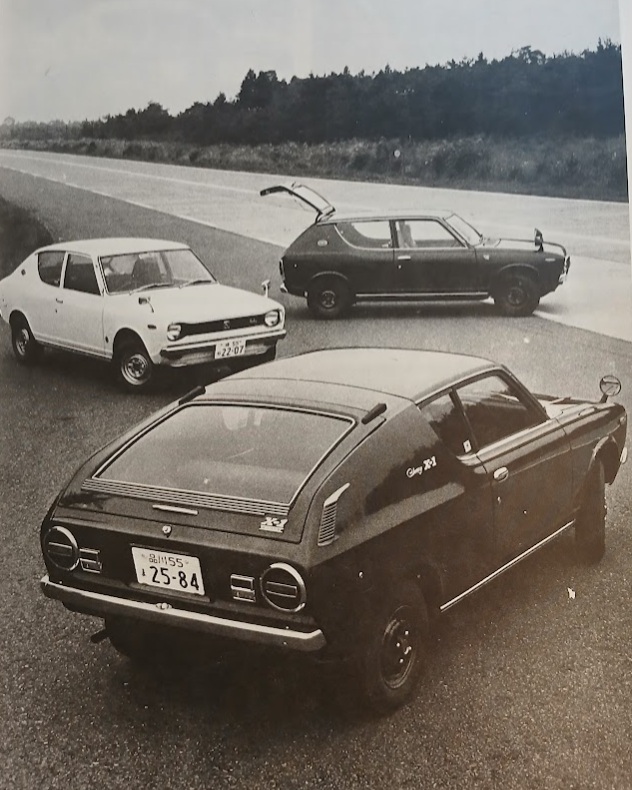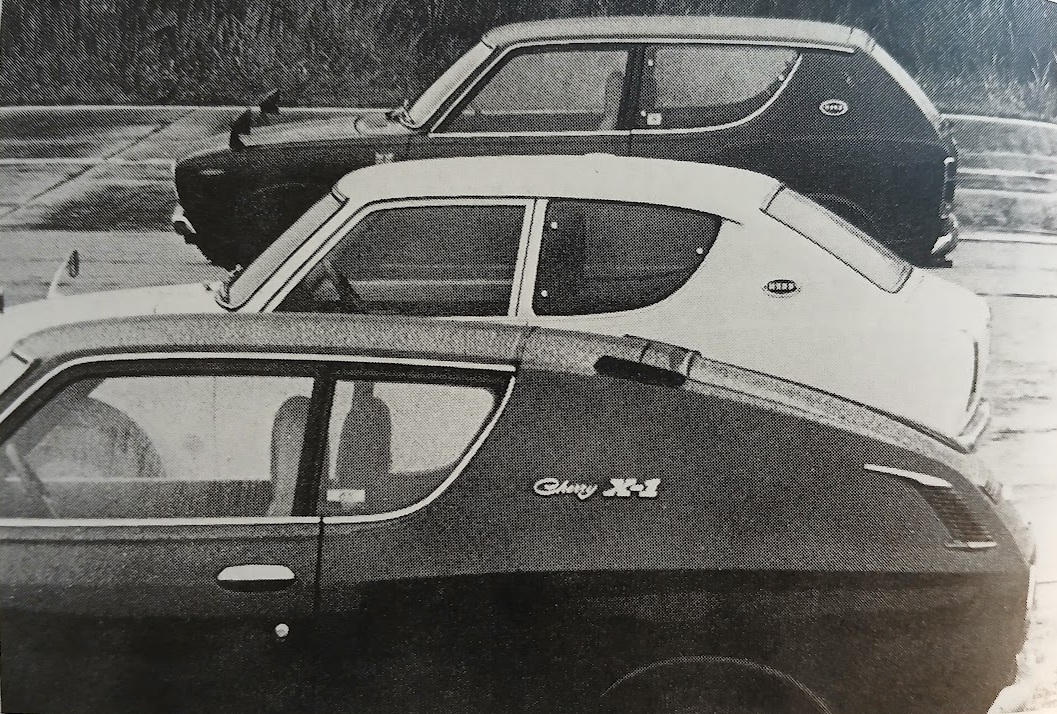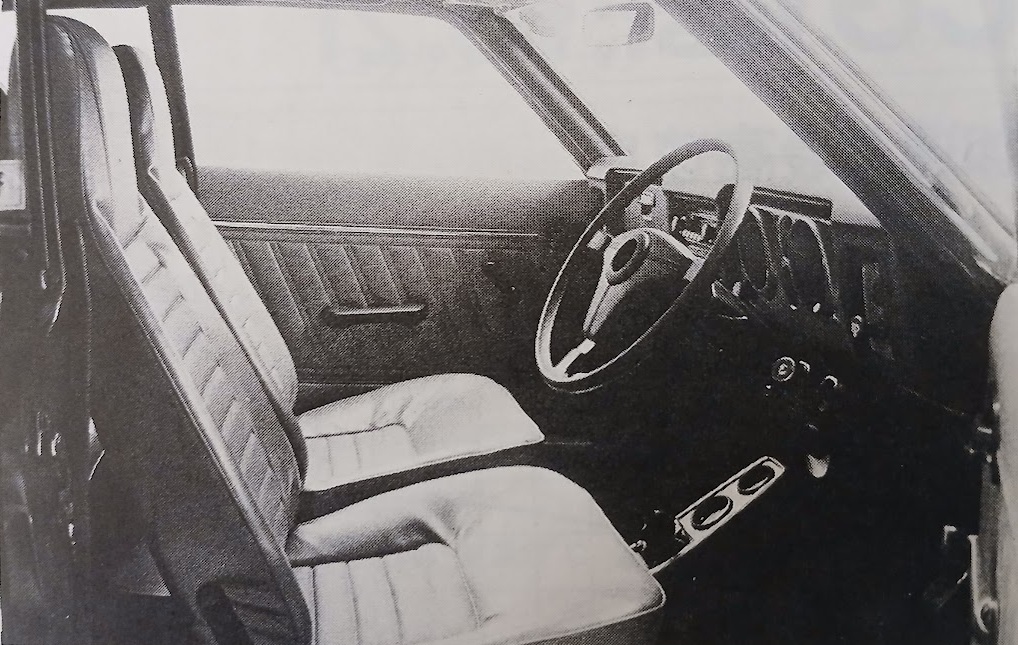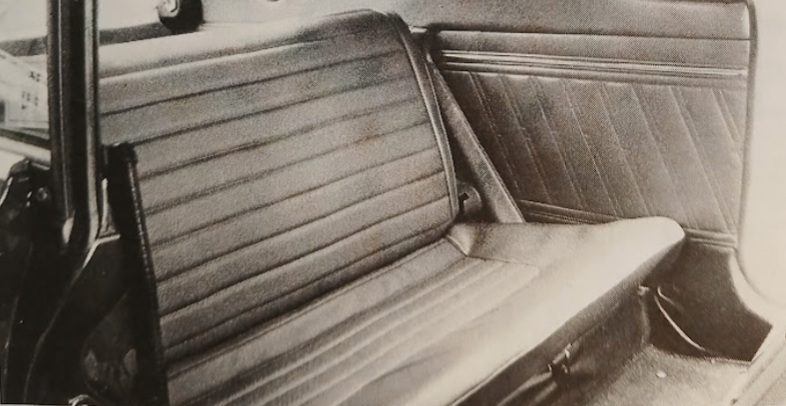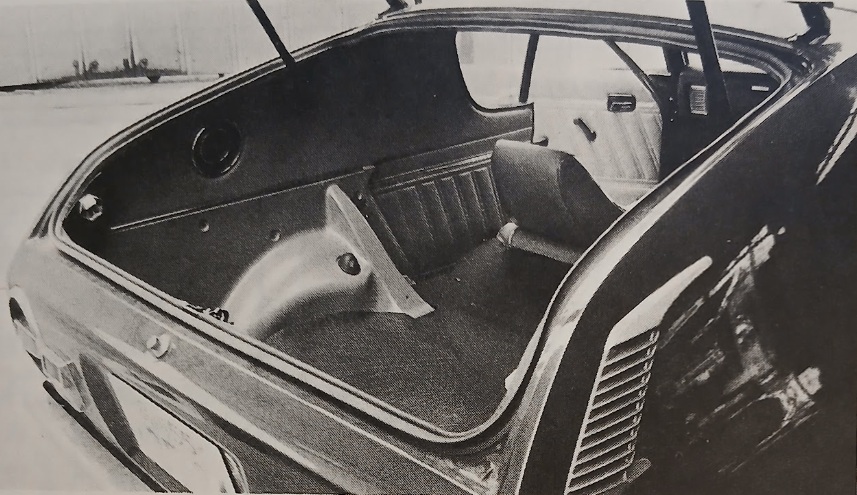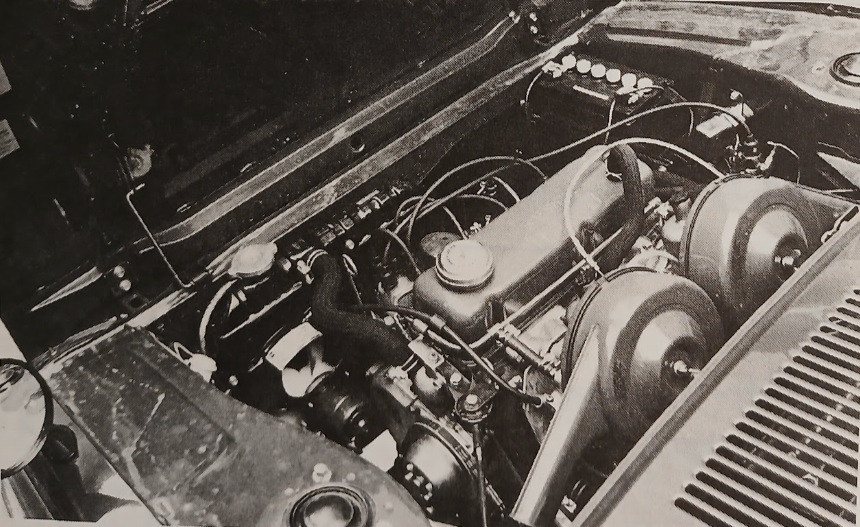Nissan Cherry Coupe X-1 (1971)
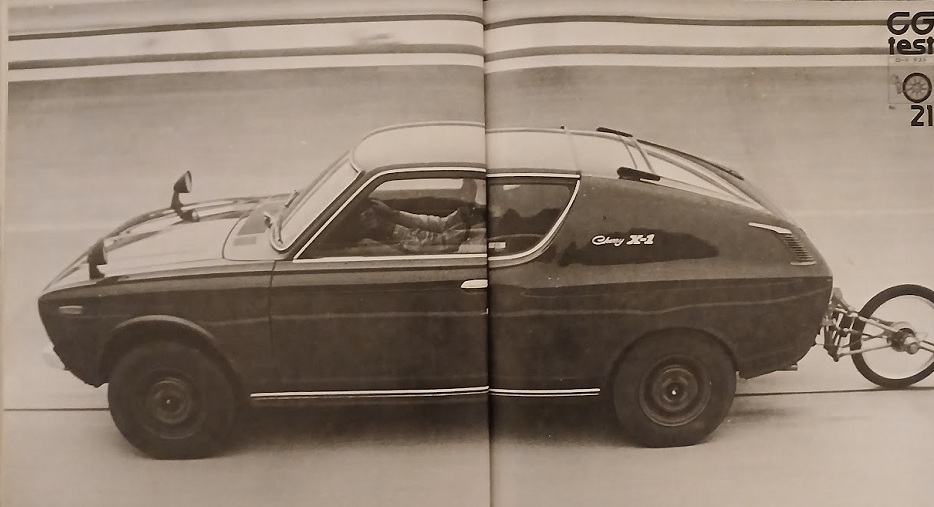
Publication: Car Graphic
Format: Road Test
Date: December 1971
Author: “C/G Test Group” (uncredited)
Road testing the Cherry Coupe X-1
Summary: Three-door coupe version of the Cherry X-1. Tailgate opens wide, can be used as a sports wagon. Rear visibility is poor. Power performance is the same as the X-1 sedan. Fan is electric, noise level is significantly reduced. Handling raises the standard for FWD, even on bias-ply tires. Disc brakes are prone to fading if used heavily. The only drawback is noise and vibration from the road surface.
Contrary to the reaction of general users, which can be inferred from sales results, C/G’s evaluation of the Nissan Cherry is extremely high. Although it is true that the basic layout was patterned after the BMC ADO15, the Cherry’s design attitude, which was unafraid of taking risks for the sake of rationality, should be appreciated among the generally orthodox designs of domestic cars.
As noted in our monthly reports, C/G purchased a Cherry Van for long-term testing, and has already been using it for 20,000km. The reason we chose a Cherry Van instead of a sedan was because we thought that the low, flat luggage compartment that only a front-wheel-drive vehicle can offer, and the wide tailgate that opens all the way to the floor, were ideal for transporting our test fifth wheel, heavy camera equipment, and the like.
Of course, we had expected from the beginning that the van would have some disadvantages compared to the sedan, and this was true when we actually began using it, so we made some modifications. The 1000cc 58ps engine, with taller gearing than that of the sedan, was not particularly satisfactory for our intended use, but the all-wheel drum brakes and truck tires were simply unbearable, so we quickly replaced them with sedan front discs and X-1 S-spec tires. The ride of the rear suspension, with leaf springs and a rigid rear axle, was also too stiff for our conditions, where we often drive with a light load, and naturally the handling stability on uneven roads was inferior. A plan to transplant the coil/trailing arm independent suspension used in the sedan had to be shelved due to legal difficulties, regardless of whether it was technically feasible or not, so in the end, the camber of the leaf springs was made flatter (while the spring rate remained the same) and the body posture was modified so that it would be level even when unladen. These modifications were a great success, and the Cherry Van became the most useful member of the C/G fleet.
However, our dream was still to have a “sports wagon” that combined the utility of the Cherry Van with the power performance and maneuverability of the X-1 sedan (in terms of styling, we still think the Van is the most beautiful, even now that the coupe has appeared). So when we heard that the Cherry Coupe was going to be announced, we immediately had the hope that it might make our dream of a sports wagon come true. To cut straight to the chase, the Cherry Coupe did not completely meet our expectations.
Unlike the sedan, the coupe is available with three engines: a twin-SU 1200cc with 80ps, a single-carburetor 1200cc with 68ps, and a 1000cc with 58ps. There are six different models depending on the interior and exterior accessories, and the prices range from 493,000 yen for the 1000 Deluxe to 593,000 yen for the X-1 L. The model we tested was the 80ps X-1 (573,000 yen). Of the four paint colors, the test car was a dark green. The coupe’s styling is quite bold, with a gently curved front screen that merges into the flat roofline, and a rear gate that opens at the end of the roof, with a wide rear window fitted into it. The most striking feature from the side is the unusually large mass of the rear quarter, which would make it look like a mid-engine GT if the car were lower (the manufacturer is well aware of this, and the optional parts include Venetian blinds to give it a Miura S look, and “heat vent” stripes to be applied to the rear quarter). One thing that bothers us a little is the vinyl strip that runs through the joint between the roof and the rear panel to hide it.
The driver’s seat and controls are the same as the sedan. However, the seat slides 20mm further back, so taller drivers can drive in a natural position. The steering wheel is relatively high and far away, so the Cherry is actually more suitable for tall people. The roof is 65mm lower, so headroom is minimal even in the front seats. When driving at Yatabe wearing a helmet, our heads sometimes touched the ceiling. The standard two-point seat belt is disappointing, given the nature of this car.
The rear seats can accommodate three people legally, on thin cushions made of urethane foam. They sit low on the low, flat floor, which is only possible with the combination of front-wheel-drive, a long wheelbase, and independent rear suspension, and provide a marginal amount of headroom. However, the backrest is nearly vertical, though not as vertical as in the van, and there is also insufficient legroom, forcing rear passengers to sit with their arms around their knees. This means that it is not a complete four-seater.
By removing the simple locking mechanism, the rear backrest can be folded flat (it automatically locks in this position), and can be connected to the rear luggage compartment to provide a wide, lined cargo floor. Unfortunately, unlike in the van, the tailgate opening does not extend all the way down to the floor. Although the tailgate opening is indeed wide at about 810mm, it is necessary to lift luggage up to waist height for loading and unloading. In practice, this turned out to be surprisingly inconvenient. At the very least, for our purposes, which required easy access to the test fifth wheel weighing about 25kg, the Cherry Coupe was a failure. As cars have become used more and more for leisure purposes in recent years, there are more opportunities to transport heavy toys such as marine engines, folding bikes, and portable generators. From our personal experience using a Mini Traveler, sports wagons that can be used as sporty cars day-to-day and as estate cars on holidays are very attractive to young people. In particular, given the popularity of the ADO15 and 16 Travelers, a Cherry sports wagon (not a coupe, but a van body with the X-1 engine and suspension) would surely be welcomed in overseas markets.
Returning to the Cherry coupe, the dashboard design is slightly different from the sedan; the crash pads across the entire panel have been made thicker, and the instruments, in the same position as before, are now sunk into deep holes. The large glovebox lid has a normal pull handle in the coupe, instead of the simple square hole used in the van (which was a good example of the Cherry’s functionalist philosophy), although it cannot be locked. The rear quarter windows, which previously had exposed metal panels, are lined in the coupe, eliminating the visually cold impression.
The biggest improvement in the coupe’s engine is the elimination of the engine-driven cooling fan and the installation of a small electric fan behind the radiator. In previous Cherries, a plastic duct connected the radiator at the front and the engine-driven fan facing the left side of the body, allowing hot air to escape into the left wheel housing. This posed no functional issues, but at engine speeds above 3000rpm the fan noise and the sound of the wind blowing through the duct became extremely loud and irritating to the ears. The 70W electric fan has six 190.6mm blades (the previous engine-driven fan was 290mm in diameter) and is attached directly to the radiator. It is automatically turned on and off by an ethyl alcohol thermoswitch placed in the water pipe connecting the radiator outlet and the engine. It starts at an operating temperature of 92°C and turns off when the temperature drops below 87°C.
What you notice immediately when you start the engine is the dramatic reduction in noise levels due to the absence of an engine-driven fan. In October temperatures, the fan doesn’t come on as long as you’re moving, not only at highway speeds, but even at low speeds in the city. It’s only when you stop at a long traffic light, or are stuck in a traffic jam and are forced to slow down, that the water temperature gauge points a little above the middle, and the fan starts to spin, accompanied by a faint hum. It’s only audible in quiet environments, and is usually drowned out by the surrounding noise and goes completely unnoticed. The fan is extremely effective, and at these temperatures it cools the water temperature within a few minutes and then turns off automatically. At present, the electric fan is only available on the Coupe, but it will eventually be available on all models. It’s a shame they didn’t have it from the start, and now that the Cherry has acquired a reputation for being noisy, it’s too late.
There are other benefits to not having an engine-driven fan besides the reduction in noise. The lack of horsepower loss will not be noticeable until you are close to top speed, but it certainly makes warming up in the morning faster. A cold start always requires the choke, and you have to pull the choke halfway for the first few minutes, but once you start driving, it will warm up to the right temperature in just two minutes.
Based on the engine of the Sunny 1200GX, the OHC 1171cc 80ps/6400rpm engine is mounted transversely in the chassis and is known for its light and smooth revving. This was also true of this test car, which had already run about 600km, and it could instantly rev from a slightly high idle of about 900rpm to 7000rpm in low gear. The yellow zone on the rev counter is 6500-6800rpm, but it is well known that a well-broken-in engine can rev close to 8000rpm. The coupe’s weight is 35kg heavier than the sedan, but at 690kg it is still light for a car of this size, and air resistance should be slightly less, so we expected power performance to be roughly the same, and in fact this proved to be the case.
The results of the top speed test at Yatabe were 157.6km/h on average for a 1km straight section, and 157.2km/h on average for a 5.5km circuit lap. There was almost no wind that day, and the highly accurate rev counter reached 6400rpm on one part of the 5.5km circuit, which corresponds to about 162km/h (the fifth wheel was removed during top speed testing because it is known that a small horsepower car of around 1200cc will lose 2-3km/h off its top speed due to the weight and running resistance of the fifth wheel), so it is safe to say that the 160km/h listed in the catalog can definitely be achieved. Incidentally, the 1000GL sedan used by the staff member who accompanied us had an average top speed of 140.7km/h on the 1km straight section.
The advantage of front-wheel-drive is that the directional stability at top speed is so good that it is hard to believe it is a light car. Just hold the steering wheel lightly and the car will go as straight as an arrow. The powertrain vibration is surprisingly small, the engine’s mechanical noise is not noticeable, and the wind noise from the body is low, so 150km/h is an easy cruising speed if the law allows. The all-synchro gearbox always makes a light gear whine, but it is never unpleasant. What is more noticeable is the road noise transmitted from the tires through to the body, which I will discuss later.
The gearing is just right for the weight and power of the car. Pushing the engine into the yellow zone at 6500rpm will give you speeds of 58, 90, and 133km/h in first, second, and third gears, respectively, with a top speed of 160km/h being equivalent to around 6200rpm in fourth, which is 300rpm below the yellow zone and within the safe zone. Acceleration is exceptionally fast for this class, even by international standards. With two people on board, the 0-400m time was recorded at 17.8 seconds (still short of the 17.3 seconds of the X-1 sedan we tested last year). This exactly the same as the C/G test time of the Sunny 1200GX Coupe, which has practically the same engine. For reference, the 0-400m acceleration data for 1200-1300cc class cars tested by C/G are: Toyota Publica 1200SL, 18.4 seconds; Honda 1300 Coupe 9, 17.5 seconds; Subaru 1300G, 18.0 seconds; and MG 1300, 19.6 seconds.
The clutch has a moderately short travel, which is rare for a Japanese car, making it easy to start quickly. On dry roads, the fastest way to start was to engage the clutch at about 4000rpm and spin the wheels very slightly. The long, sturdy gear lever makes gearchanges sure and light, far superior to other transverse engine, front-wheel-drive cars like the BMC Mini and Fiat 128.
The engine has good torque characteristics and shows sharp response over a wide range from 2500 to 6000rpm. Acceleration at high speeds is above average for this size of car, and even at 120km/h, it responds clearly to the throttle, and only after 140km/h does it slow down. On the other hand, the behavior of the test car at very low speeds seemed abnormal compared to our memory of driving the X-1 sedan. The X-1 sedan could accelerate smoothly from just 25km/h (about 1000rpm) in top gear, but this coupe could only maintain 40km/h in top gear. This was supported by the fact that the fuel consumption at a constant speed of 40km/h was terrible compared to 60km/h, and was also shown by the fact that when we were forced to drive at slower than walking speed in traffic, it was impossible even in low gear, and we often had to disengage the clutch. We hope this was just an one-off malfunction of the test car.
The Sunny 1200GX, which uses the same engine, is well known for its economical fuel consumption, and the Cherry X-1 is no different. The average fuel economy throughout the test was only 9.1km/l, but it is unlikely to fall much below 10km/l even under the worst conditions. It is particularly good when cruising on the highway at about 80-120km/h, although 15km/l may be a bit hard to achieve. The compression ratio is 9.0, but there is no sign of pinking even with regular gasoline.
The disc/drum brakes are fine in practical use. Although there is no servo, the pedal pressure is light, and it showed a braking force of 0.80g at 30kg. However, the lightly loaded rear wheels tend to lock up when braking suddenly. In the 0-100-0 fade test, the smell of burning brake pads began to be detected around the fourth stop, and fade was clearly evident from the sixth stop. The pedal force, which was 23kg at first, increased to 42kg by the seventh stop. The coupe’s taillights are large and circular, but the important brake lights are obstructed by the surrounding chrome trim rings, making them difficult to see from diagonally behind even when illuminated.
The coupe’s handling is almost exactly the same as the X-1 sedan. Weight distribution is 62.3%/37.7% (the sedan is 65.6%/34.4%) when unladen, but nose-heaviness is hardly a problem, and with the wide track and grippy (at least on dry roads) standard 6.00S12-4PR tires (Toyo E-31 on the test car), cornering speeds are extremely high. The rack-and-pinion steering has 3.2 turns lock-to-lock, has no play when going straight, which is rare for a Japanese car, and is moderately quick and always light. The turning radius of 4.6m is unusually small for a front-wheel-drive car. If you release your throttle foot in the middle of a corner, the cornering power is restored, and the tendency to tighten the turn towards the inside (called tuck-in) is much stronger than, for example, the Cherry 1000GL sedan, and drivers accustomed to front-wheel-drive cars will use this to their advantage. Generally, body roll is moderate, but when applying full power in second gear in a tight corner, the inside front wheel tends to spin violently for a moment, especially on wet roads. For safety on wet roads, the optional 155SR-12 radials would be ideal, but as I will explain later, even with bias-ply tires, road noise is severe, so I cannot recommend radial tires for this car.
As for ride quality and noise, the long-wheelbase, all-independent suspension Cherry generally offers a flat, comfortable ride, especially when going over gentle undulations at high speeds, where the body stays flat like a much larger, heavier vehicle. However, the suspension stroke is short, and even if the load is not particularly heavy, the car bottoms easily (especially at the front) when driving on rough pavement. Another concern is the insufficient insulation of noise from the road surface and the trembling vibrations caused by the lack of rigidity in the entire body. The standard tires of the X-1 are highly rigid bias-ply tires, which, as we have already mentioned, contribute greatly to the handling. On the other hand, these tires pick up imperfections in the road surface faithfully, which causes the thin body panels to vibrate slightly. We have tried three types of tires for the Cherry X-1 (Yokohama Y-205, Bridgestone Skyway H, and Toyo E-31), and the Toyo tires that came with this coupe were the hardest and noisiest. If you are sitting in the passenger’s seat and use the left wheel housing as a footrest, the shock of picking up the joints in the pavement is transmitted clearly through the soles of your shoes. The rigidity of the entire body is also insufficient, and the scuttle vibrates considerably on uneven surfaces, so unless the road is as smooth as a mirror, the noise and vibration from the road will cancel out the benefit of the reduced engine noise. However, sacrificing the light weight, which is the best thing about the Cherry, in order to kill the noise and vibration would be a complete loss. I would like to see this problem solved by giving the suspension more compliance or by effectively attaching anti-vibration damping materials to the body panels.
A problem with this type of coupe, which is a recent trend, is the limited visibility to the rear. This drawback is particularly pronounced in the Cherry Coupe, where, due to its distinctively wide rear quarter panel, if you are not careful, another vehicle diagonally behind you at close range will be out of the field of view of the fender mirror (which is bullet-shaped and has an extremely narrow field of view) and the interior mirror, and may suddenly appear to the side, startling you. Similarly, when backing out of a narrow parking space, the high-back seat also blocks your view of the rear. Although it has been extended by 80mm, it is reassuring that the rear overhang is still much shorter than it would appear from inside the car.
The interior equipment includes a variety of superfluous items, but the functional parts that are truly necessary for practical use are optional. For example, a heated rear window, intermittent wipers, and three-point seat belts are optional equipment even in the highest-end models, and these should be standard equipment no matter what.
Postscript: Story Photos
